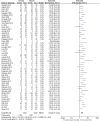Histopathological predictors of lymph node metastasis in oral cavity squamous cell carcinoma: a systematic review and meta-analysis
- PMID: 38835393
- PMCID: PMC11148647
- DOI: 10.3389/fonc.2024.1401211
Histopathological predictors of lymph node metastasis in oral cavity squamous cell carcinoma: a systematic review and meta-analysis
Abstract
Objectives: Lymph node metastasis (LNM) is the most significant parameter affecting overall survival in patients with oral cavity squamous cell carcinomas (OCSCC). Elective neck dissection (END) is the standard of care in the early management of OCSCC with a depth of invasion (DOI) greater than 2-4 mm. However, most patients show no LNM in the final pathologic report, indicating overtreatment. Thus, more detailed indicators are needed to predict LNM in patients with OCSCC. In this study, we critically evaluate the existing literature about the risk of different histological parameters in estimating LNM.
Methods: A systematic review was conducted using PRISMA guidelines. PubMed, Web of Science, Cochrane, and Scopus were searched from inception to December 2023 to collect all relevant studies. Eligibility screening of records was performed, and data extraction from the selected studies was carried out independently. Inclusion in our systematic review necessitated the following prerequisites: Involvement of patients diagnosed with OCSCC, and examination of histological parameters related to lymph node metastasis in these studies. Exclusion criteria included animal studies, non-English articles, non-availability of full text, and unpublished data.
Results: We included 217 studies in our systematic review, of which 142 were eligible for the meta-analysis. DOI exceeding 4 mm exhibited higher risk for LNM [Risk ratio (RR) 2.18 (1.91-2.48), p<0.00001], as did perineural invasion (PNI) [RR 2.04 (1.77-2.34), p<0.00001], poorly differentiated tumors [RR 1.97 (1.61-2.42), p<0.00001], lymphovascular invasion (LVI) [RR 2.43 (2.12-2.78), p<0.00001], groups and single pattern of invasion [RR 2.47 (2.11-2.89), p<0.00001], high tumor budding [RR 2.65 (1.99-3.52), p<0.00001], tumor size over 4 cm [RR 1.76 (1.43-2.18), p<0.00001], tumor thickness beyond 4 mm [RR 2.72 (1.91-3.87), p<0.00001], involved or close margin [RR 1.73 (1.29-2.33), p = 0.0003], and T3 and T4 disease [RR 1.98 (1.62-2.41), p <0.00001].
Conclusion: Our results confirm the potential usefulness of many histopathological features in predicting LNM and highlight the promising results of others. Many of these parameters are not routinely incorporated into pathologic reports. Future studies must focus on applying these parameters to examine their validity in predicting the need for elective neck treatment.
Keywords: lymphatic metastasis; neck dissection; oral cancer; overtreatment; predictors; squamous cell carcinoma of head and neck; standard of care.
Copyright © 2024 Alqutub, Alqutub, Bakhshwin, Mofti, Alqutub, Alkhamesi, Nujoom, Rammal, Merdad and Marzouki.
Conflict of interest statement
The authors declare that the research was conducted in the absence of any commercial or financial relationships that could be construed as a potential conflict of interest.
Figures
Similar articles
-
Nodal Metastasis in Surgically Treated Oral Cavity Squamous Cell Carcinoma.ORL J Otorhinolaryngol Relat Spec. 2023;85(6):348-359. doi: 10.1159/000534491. Epub 2023 Nov 15. ORL J Otorhinolaryngol Relat Spec. 2023. PMID: 37967536 Free PMC article.
-
Re-examining predictors of pathologic lymph node positivity in clinically node negative oral cavity cancer.Oral Oncol. 2023 Sep;144:106490. doi: 10.1016/j.oraloncology.2023.106490. Epub 2023 Jul 4. Oral Oncol. 2023. PMID: 37413770
-
Development and Validation of Machine Learning Models for Predicting Occult Nodal Metastasis in Early-Stage Oral Cavity Squamous Cell Carcinoma.JAMA Netw Open. 2022 Apr 1;5(4):e227226. doi: 10.1001/jamanetworkopen.2022.7226. JAMA Netw Open. 2022. PMID: 35416990 Free PMC article.
-
Assessment of the Rate of Skip Metastasis to Neck Level IV in Patients With Clinically Node-Negative Neck Oral Cavity Squamous Cell Carcinoma: A Systematic Review and Meta-analysis.JAMA Otolaryngol Head Neck Surg. 2019 Jun 1;145(6):542-548. doi: 10.1001/jamaoto.2019.0784. JAMA Otolaryngol Head Neck Surg. 2019. PMID: 31070693 Free PMC article.
-
Risk factors for lymph node metastasis in T1 esophageal squamous cell carcinoma: A systematic review and meta-analysis.World J Gastroenterol. 2021 Feb 28;27(8):737-750. doi: 10.3748/wjg.v27.i8.737. World J Gastroenterol. 2021. PMID: 33716451 Free PMC article.
Cited by
-
The Detection of Lung Cancer Cell Profiles in Mediastinal Lymph Nodes Using a Hematological Analyzer and Flow Cytometry Method.Cancers (Basel). 2025 Jan 27;17(3):431. doi: 10.3390/cancers17030431. Cancers (Basel). 2025. PMID: 39941799 Free PMC article.
-
Multi-omics analysis to uncover the molecular basis of tumor budding in head and neck squamous cell carcinoma.NPJ Precis Oncol. 2025 Mar 13;9(1):73. doi: 10.1038/s41698-025-00856-2. NPJ Precis Oncol. 2025. PMID: 40082664 Free PMC article.
-
The Role of Blood Inflammatory Biomarkers and Perineural and Lympho-Vascular Invasion to Detect Occult Neck Lymph Node Metastases in Early-Stage (T1-T2/N0) Oral Cavity Carcinomas.Cancers (Basel). 2025 Apr 12;17(8):1305. doi: 10.3390/cancers17081305. Cancers (Basel). 2025. PMID: 40282481 Free PMC article.
References
-
- Ding Z, Li Y, Pan X, Xuan M, Xie H, Wang X. Sentinel lymph node biopsy versus elective neck dissection in squamous cell carcinoma of the oral cavity with a clinically N0 neck: Systematic review and meta-analysis of prospective studies. Head Neck. (2021) 43:3185–98. doi: 10.1002/hed.26803 - DOI - PubMed
-
- Arora A, Husain N, Bansal A, Neyaz A, Jaiswal R, Jain K, et al. . Development of a new outcome prediction model in early-stage squamous cell carcinoma of the oral cavity based on histopathologic parameters with multivariate analysis: the aditi-nuzhat lymph-node prediction score (ANLPS) system. Am J Surg Pathol. (2017) 41:950–60. doi: 10.1097/PAS.0000000000000843 - DOI - PubMed
Publication types
LinkOut - more resources
Full Text Sources






